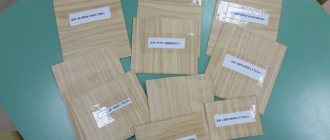Definition of the concept of environmental education
Environmental education is the inculcation of moral categories that are responsible for developing a caring attitude towards the environment in a person.
Environmental education should begin from preschool age, since it is at this moment that a person develops a set of basic moral values. Note 1
As part of environmental education, the child becomes familiar with the basic concepts of nature, realizes that he is part of this nature, and that people are responsible for almost everything that happens on our planet. The child must learn to take care of the environment. These goals and objectives are precisely realized within the framework of environmental education.
Are you an expert in this subject area? We invite you to become the author of the Directory Working Conditions
Organization of the subject-game environment
To implement the objectives of the program, a subject-development environment is formed in a preschool institution, the purpose of which is to awaken the child’s interest in the world around him, the desire to know it and take part in its formation.
The environmental center includes indoor plants, their passports with a graphic depiction of methods of care, frequency of watering, method of reproduction, and light-loving behavior. The list of plants for each age of children is determined by the curriculum.
Here are tools for loosening the soil, replanting, cutting, spraying and watering plants. For preschoolers to work, aprons are purchased with the expectation that there will be at least 5 people in the group. While working in an indoor flower garden, children observe the growth of flowers, make simple conclusions about the process of plant formation, and determine the decisive factors in changing the height, shape, color of leaves, and the formation of buds.
Nearby you can place a mini-garden with onions, parsley, dill, and berries. It can be designed in the form of a train, a fairy-tale meadow, or cartoon characters. By observing the development and growth of plantings, preschoolers become familiar with their beneficial properties, method of consumption and set of vitamins.
In the ecological center there can be a living corner with 2-3 representatives of fauna: a hamster, a mouse, a guinea pig, a parrot. The kids' tasks include caring for their pets on a daily basis. The guys understand that without their care, the inhabitants of the corner could die. Meanwhile, being in the group with them is fun and cozy. An activity-game with pets teaches preschoolers and schoolchildren empathy, a reverent attitude towards them, and observation of how pets grow and take care of themselves.
The cognitive and practical center in the group involves elements of research activity in the concept of “ecological education”; it is a mini-laboratory for games and work with children to develop their own projects, hypotheses, and discoveries.
Such a center can be equipped with a microscope, mirrors, flasks, liquids for mixing, and lenses. By studying a leaf, grain, or fluff under a magnifying glass, children become familiar with the structure of the object, its density, and color scheme. This is a good way, using the possibilities of play, to cultivate perseverance, observation, and develop the analytical abilities of preschoolers and schoolchildren.
Thematic environmental stations are organized on playgrounds with the aim of studying objects of living and inanimate nature.
Ecology for children also includes the stations “Forest”, “Flower Garden”, “Vegetable Garden”, “Meadow”, “Field”, “Pond”, “People’s Pharmacy”, which would be more appropriate to equip on the territory of the kindergarten near the playground.
Here the children observe the flora of their region and learn how to care for vegetable crops in open ground conditions. Signs with pictures of vegetables will serve as a guide for observing and working in your garden. Two or three pines and several spruce trees will create a small forest corner where you can observe the growth of trees, the appearance of young shoots on the branches, study the cones of coniferous trees and find their differences.
A small area of unmown grass will be a good imitation of a meadow, where preschoolers will observe the life and behavior of insects, beetles, and worms. And the sown wheat, rye, and barley will allow you to form an idea about the origin of bread and teach you how to treat it with care. On an artificial pond, children can observe the plants of the reservoir: water lily, duckweed, reeds, sedge. Snails and small fish should be released into the depths of the mini-reservoir. Butterflies and dragonflies will choose a place to rest here.
Functional ecological stations include the “Bird Canteen”, “Meteorological Station”, “Skillful Hands”.
In them, children learn to compose the simplest chains of ecology, determine the direction and strength of wind movement, and the weather. Here, using natural and waste materials, preschoolers are engaged in making crafts, testing wood, stems, and cones for strength, flexibility, and fragility. Games at stations help develop children's thinking processes, moral qualities, and fine motor skills.
Prohibitory signs located at stations, in the form of a game, will reinforce children’s knowledge of the rules of behavior in nature, teach them to appreciate the ecology of their region, and help bring the environmental education of preschoolers into line with the requirements of the curriculum.
Forms of environmental education
There are the following forms of environmental education:
- educational activities
- excursions
- themed holidays
- getting to know nature in everyday life
- work activity
- exhibitions, competitions, olympiads
Educational activities are the leading method of introducing students to nature and the surrounding world. In the process of educational activities, the teacher systematically provides knowledge about natural phenomena and objects to children, taking into account their age, psychological characteristics and the specifics of the area in which the children live.
Classes can have several varieties:
- introductory lessons
- generalizing lessons
- in-depth educational lessons
During introductory lessons, students can become familiar with different species of animals, plants and natural phenomena that are not found in their area. During the lesson, the teacher uses a large number of visual aids. They help students develop correct ideas about the topic of the lesson.
Finished works on a similar topic
Course work Methods and forms of environmental education 410 ₽ Abstract Methods and forms of environmental education 240 ₽ Examination Methods and forms of environmental education 190 ₽
Receive completed work or specialist advice on your educational project Find out the cost
During a generalization lesson, children learn to generalize their knowledge regarding certain natural phenomena and objects. During this lesson, children learn to analyze, compare, and generalize.
During an in-depth cognitive lesson, children expand their knowledge of the phenomena that they see every day in everyday life. The teacher supplements the existing information with new information.
Excursions occupy a special place in the process of environmental education. During excursion lessons, children can get acquainted with natural phenomena in a natural setting. It is advisable to conduct excursions to the same places at different times of the year so that children can notice seasonal natural changes.
Themed holidays are very interesting for children and adults. They can be dedicated to a certain time of year, natural phenomena, animals, etc. The peculiarity of this form of work is that children develop a positive response to it in their consciousness.
In a preschool institution, during daily walks, the teacher introduces children to natural phenomena and materials, for example, children play in the sand, with snow, and with fallen leaves.
Labor activity occupies a special place in the process of environmental education. Labor activity is exciting for children; it can take place in the garden, vegetable garden or flower garden. Children can plant seeds, water plants, remove weeds, and harvest crops. Any work activity instills in children a love of work and independence, and in the process of environmental education, in addition, there is the formation of responsibility for the surrounding nature.
Children can take part in various competitions and quizzes, where they can demonstrate their knowledge about objects and natural phenomena, and children can also make crafts from natural materials.
S.N. Nikolaev
System of environmental education for preschool children
Svetlana Nikolaevna Nikolaeva – Doctor of Pedagogical Sciences, chief researcher at the Institute of Psychological and Pedagogical Problems of Childhood of the Russian Academy of Education.
Reviewers:
Kudryavtsev V.T. – Doctor of Psychological Sciences, Professor, Head of the Department of Theory and History of Psychology at the Institute named after. L. S. Vygotsky.
Kavtaradze D.N. – Doctor of Biological Sciences, Professor, Head of the Laboratory of Ecology and Nature Conservation of the Department of Higher Plants, Faculty of Biology, Moscow State University, laureate of the Presidential Prize of the Russian Federation in the field of education.
Tsvetkova I.V. – Doctor of Pedagogical Sciences, Professor of Moscow State Pedagogical University. M.A. Sholokhov.
Galitskaya I. A
–
Candidate of Philosophy, leading researcher at the State Research Institute of Family and Education of the Russian Academy of Education.
about the author
Nikolaeva Svetlana Nikolaevna (b. 1940) – Doctor of Pedagogical Sciences, researcher in the field of environmental education, chief researcher at the Institute of Psychological and Pedagogical Problems of Childhood of the Russian Academy of Education.
She began her career as a teacher in one of the Moscow kindergartens. After graduating from Moscow State Pedagogical Institute. V.I. Lenina worked at the Research Institute of Preschool Education of the Academy of Pedagogical Sciences. She was a student of a prominent galaxy of domestic scientists: psychologists (V.S. Mukhina, A.V. Zaporozhets, N.N. Poddyakov, L.A. Wenger) and teachers (E.I. Zalkind, D.V. Mendzheritskaya, A.P. Usova , T. A. Markova, N. A. Vetlugina). Until 1979, she was engaged in research on the issues of mental education of preschoolers in the process of introducing them to nature. From 1980 to the present day, he has been engaged in research in the field of environmental education for preschool children.
S. N. Nikolaeva is the author of the first “Program of Environmental Education for Preschool Children” (1993), which later became the “Young Ecologist” program, and the first “Concept of Environmental Education for Preschool Children.” In 1992, a theoretical monograph “Communication with nature begins in childhood” was published, in which the author analyzes and summarizes research that made it possible to define a new – ecological – approach to introducing preschoolers to nature. From this moment the author’s intensive work in the field of environmental education begins. In 2006, S. N. Nikolaeva defended her thesis for Doctor of Pedagogical Sciences.
A contribution to preschool pedagogy is the author’s holistic system of environmental education for children from 2 to 7 years old in kindergarten and family settings, the theoretical justification of which is presented in this publication. The system defines the content and methods of environmental education for preschoolers, a program for preschool institutions, reveals the concept of “technology,” and presents a sequence of technologies for children of all age groups. Technologies for the “Young Ecologist” program allow practitioners to form the beginnings of an ecological culture in preschoolers. Adult education is also part of the system: the training of specialists in colleges and universities is carried out using the textbooks of S. N. Nikolaeva “Methods of environmental education of preschool children. Textbook for students of secondary pedagogical educational institutions" and "Theory and methods of environmental education for children. Tutorial. For students of preschool education faculties of higher pedagogical educational institutions." In the system of advanced training for preschool workers, the manual “Environmental education of children in preparation for school” is often used.
The sphere of today's scientific interests of S. N. Nikolaeva is the issues of comprehensive intellectual and personal development of children in the system of environmental education.
Preface
The progress of modern civilization is largely due to the rapid development of natural science, in particular, the biosphere sciences, in which all earthly processes are considered in interconnection, in the unity and interdependence of their manifestations. Ecology among these sciences acquires special significance.
In recent decades, the development of two parallel processes has been clearly visible - the worsening of the planet’s environmental problems and their understanding by the Earth’s population. In Russia, as in other countries, a system of continuous environmental education is being established, and a conceptual vision of this process is being formed. The initial link in the environmental education system is the sphere of preschool education.
It is obvious that it is at the stage of preschool childhood that the first worldview is formed: the child receives emotional impressions of nature, accumulates ideas about different forms of life, that is, the fundamental basis of ecological thinking and consciousness is formed, and the initial elements of ecological culture are laid. But this happens only on the condition that the adults raising the child themselves have an ecological culture: they understand universal problems and are concerned about them, show the child the beautiful world of nature, and help establish relationships with him.
Preface
The progress of modern civilization is largely due to the rapid development of natural science, in particular, the biosphere sciences, in which all earthly processes are considered in interconnection, in the unity and interdependence of their manifestations. Ecology among these sciences acquires special significance.
In recent decades, the development of two parallel processes has been clearly visible - the worsening of the planet’s environmental problems and their understanding by the Earth’s population. In Russia, as in other countries, a system of continuous environmental education is being established, and a conceptual vision of this process is being formed. The initial link in the environmental education system is the sphere of preschool education.
It is obvious that it is at the stage of preschool childhood that the first worldview is formed: the child receives emotional impressions of nature, accumulates ideas about different forms of life, that is, the fundamental basis of ecological thinking and consciousness is formed, and the initial elements of ecological culture are laid. But this happens only on the condition that the adults raising the child themselves have an ecological culture: they understand universal problems and are concerned about them, show the child the beautiful world of nature, and help establish relationships with him.
This monograph presents a theoretical (philosophical, natural science and psychological-pedagogical) justification for the methodology of environmental education of children, which, although new, has already entered the educational space of preschool institutions. Based on many years of research by the author and his students, it is shown how the content of environmental education for children crystallizes, what mechanisms ensure its implementation, and contribute to building the foundation of environmental culture.
The research began in the 70s of the 20th century: a preschool natural history group was created in the psychological and pedagogical laboratory of mental education of the Scientific Research Institute of Preschool Education of the Academy of Pedagogical Sciences of the USSR. The direction is headed by Candidate of Biological Sciences (later Doctor of Psychological Sciences) K. E. Fabry. The laboratory creates a synthesis of sciences - preschool pedagogy, child psychology and natural science - that is effective for building a system of environmental education for preschool children.
Like all members of the laboratory, the group’s researchers are aimed at finding new content for teaching preschoolers - content that reflects the leading patterns of the surrounding reality and can intensively develop children’s mental abilities. The basis of the new content in the group’s developments is the universal pattern of nature – the unity of the organism and the environment. This pattern is observable, as it has clear external manifestations that reflect the adaptive relationship of all living things with their environment. A pattern can also be found in the ontogenesis of organisms, and its phylogenetic result is the diversity of living beings. The idea of new content in introducing preschoolers to nature, approved by colleagues, was first presented in the 1972 monograph “Mental Education of Preschoolers.”
Since the late 70s, dissertation research has been completed one after another (S. N. Nikolaeva, A. M. Fedotova, T. V. Khristovskaya, L. S. Ignatkina, I. A. Komarova). During these same years, research on this problem was carried out in other institutions of the country, in particular, in Leningrad - at the Leningrad State Pedagogical Institute named after. A. I. Herzen at the Department of Preschool Pedagogy (P. G. Samorukova, I. A. Khaidurova, E. F. Terentyeva, N. N. Kondratyeva). By the 90s, many interesting facts had accumulated, reflecting the ability of preschool children to acquire new content of knowledge about nature; researchers are getting interesting results about the way children learn. An analysis of the accumulated material is presented in the general work of S. N. Nikolaeva “Communication with nature begins in childhood” (1992). The monograph becomes a theoretical foundation on which it is already possible to build the “infrastructure” (program and methodological support) of a new area of preschool pedagogy - environmental education.
In 1993, the first “Program of Environmental Education for Preschool Children” was published, which, subsequently refined and expanded, became the “Young Ecologist” program. In 1996, the “Concept of Environmental Education for Preschool Children” was published, which outlines all the key positions: content and methods of environmental education; pedagogical synthesis of educational and educational components (knowledge and attitude); the role of the teacher as a carrier of ecological culture; scheme for managing environmental education. The task arises of creating methodological manuals that will allow introducing a new approach to introducing children to nature into preschool institutions. In 1995, the first technology “Education of environmental culture in preschool childhood” was released for working with children of the preparatory group under the “Young Ecologist” program. This book is the first in a series of teaching aids (technologies) for working with children of senior and middle groups, and junior preschool age. The concept and program, combined with technology, allow any preschool institution to implement a system of introducing children to nature in a new – ecological – key.
In the 90s, research continued: T. A. Fedorova tested a new - environmental-economic - aspect of the content of the methodology, the possibility of implementing initial environmental management in kindergarten. T. G. Tabukashvili’s research reveals the conditions for the formation and development of professional ecological culture of students in the preschool department of a pedagogical college. These conditions are: a course of a new methodology - methods of environmental education, an environmentally-developing environment of an educational institution and a cycle of extra-curricular activities of an environmental nature.
Further research in the field of environmental education of preschool children concerns adults raising children and creating conditions for the formation of the beginnings of an environmental culture in them. This is a publication of textbooks that allow students of pedagogical colleges and universities to master a new methodology and acquire an ecological worldview, as well as the development of a manual that addresses issues of management, setting up methodological work with the teaching staff and creating an environmentally-developmental environment in a preschool institution. Taken together, these materials make it possible to put into practice the concept of “The educator is the bearer of ecological culture.” The publications embody the author’s vision of the system of environmental education for preschool children.
The author expresses gratitude to all the employees of the Institute of Preschool Education, who in one way or another supported the research of the preschool natural history group and participated in their promotion. Special thanks to Academician, Doctor of Psychology, Professor Nikolai Nikolaevich Poddyakov, who first as the head of the laboratory and then the director of the institute for many years supported research in this area and ensured a high level of content of scientific work.
Any research needs to be verified by practice, therefore, since the release of the first “Program of Environmental Education for Preschool Children,” fruitful cooperation has been developing with a number of preschool institutions in Moscow. For many years (more than 15 years) of joint work, the author expresses gratitude to the District Education Departments and teaching teams: Preschool Educational Institution No. 1012 SEOU (headed by G. S. Ivanova), Preschool Educational Institution No. 1691 Higher Educational Institution (headed by T. M. Novikova), Preschool Educational Institution No. 403 SVOU ( leader T.N. Zenina). Year after year, in an experimental mode, these institutions are testing: the content of environmental education presented by the “Young Ecologist” program, new methods and forms of organizing work with children, environmental and pedagogical technologies for different age groups, a scientific and methodological seminar as a form of advanced training for children’s teachers garden
The author also expresses gratitude to all the practitioners in Russia who to this day are introducing the “Young Ecologist” program and methodological support for it into the work of preschool institutions.
Thanks to the organizers of all-Russian conferences that contributed to the dissemination of the ideas of environmental education of preschool children: former leading specialist of the Ministry of Natural Resources N. F. Tsertsik, member of the board of the presidium of the All-Russian Society for Nature Conservation V. I. Efimova.






